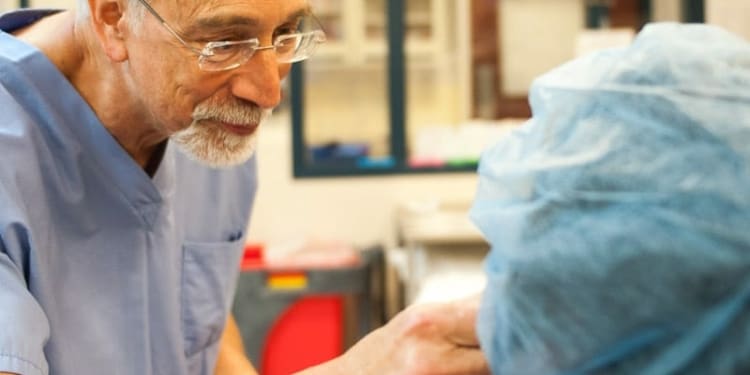#DrAllenZieker #EyeDoctor #Astigmatism #Colonie #JimFranco #SpotlightNews
COLONIE — After more than 33,000 cataract surgeries, Dr. Allen W. Zieker isn’t worried about Tuesday, July 31, when he will perform an implant using an revolutionary new lens developed by Bausch + Lomb to treat astigmatism for the first time in this country.
“The evolution of products to make life better for people is just fantastic,” he said while in an operating room at the Albany Regional Eye Surgery Center on Johnson Road. “It’s a tried and true platform and material, but they are adding the astigmatic component to it. They are combining the best of these two worlds into the newest project and it will help a lot of people.”
 The new lens, just approved by the Federal Drug Administration in June, follows the same logic as the implants used to cure cataracts — you take the old lens out and replace it with a new one. Except, rather than replacing the old lens that has cataracts, a cloudiness often associated with aging but can have other causes, the latest version can also address focus issues associated with astigmatism.
The new lens, just approved by the Federal Drug Administration in June, follows the same logic as the implants used to cure cataracts — you take the old lens out and replace it with a new one. Except, rather than replacing the old lens that has cataracts, a cloudiness often associated with aging but can have other causes, the latest version can also address focus issues associated with astigmatism.
Basically, an astigmatism is when the cornea is cone-shaped rather than oval, like a football rather than a basketball, Zieker said.
“The basketball can and does focus on one point, while a football-shaped cornea focuses on two points with a blur in the middle,” he said. “The new lenses that we will use will neutralize the patient’s astigmatism they bring to us when they come in the door. For example if they have a plus two in one direction, we put a minus two in the other direction and they cancel each other out and the patient sees better because of it.”
The new lens, formally called the enVista One Piece hydrophobic acrylic Toric Intraocular Lens, or simply the enVista IOL, is made out of acrylic and is the only lens scientifically shown to not develop glistenings, or microscopic spots of water. While microscopic, when there are thousands of them, it can cut down on the amount of light that reaches the eye and impact vision, Zieker said.

Acrylic is not biodegradable, it doesn’t wear out and “has come a long what over the last 25 years,” Zieker said. Also, it is more stable than its predecessors and that is essential to addressing astigmatism because if the lens rotates inside the eye it will not be as accurate of a fix.
The first implant was tried some 300 years ago when doctors in Italy made them out of glass without much success. They were just too heavy to be practical, Zieker said.
Then, during World War II, Air Force pilots were getting shot during the Battle of Britain and pieces of their canopies were getting in their eyes. The canopies were made of Perspex, or polymethyl methacrylate, the scientific name what is better known as plexiglass, and while certainly an inconvenience for the pilots, a medical student noticed the body wasn’t rejecting the material and it kicked off a milestone in the development of lens implants.
“And they refined it and refined it and we are now where we are today, several generations later, with a whole material and one that is finely machined and perfectly polished and really beautiful stuff,” said Zieker. “This is the next level. I’ve seen the one before this one, and the two before that so if I need to go back to another level I can do that because I’ve used all of them.”
New Jersey born and raised, Zieker said he wanted to be a doctor since he was 7 years old and initially had notions of becoming a family practitioner and taking care of people from “the cradle to the grave” from childbirth to appendectomies.”
But, he said, as he was getting out of Albany Medical School, there was a malpractice crisis and without intense training in specialized fields a lawsuit was waiting around the corner.
“If I had a complication with a baby that anyone else would have I would have been condemned because I didn’t have three years of obstetrics. I would have been trained but not trained to that level,” he said. “So, I told myself I would do three years of medicine and a year of pediatrics and I’ll take care of the family medically. But I got into that and it was really boring and I couldn’t do anything with my hands so I thought back to medical school and ophthalmology was interesting so I did an elective for a month and it was like a light went off ‘this is what I want to do.’”
In his more than 33 years of practice, Zieker has done more than 33,000 implant surgeries, more than anyone else in the country.



